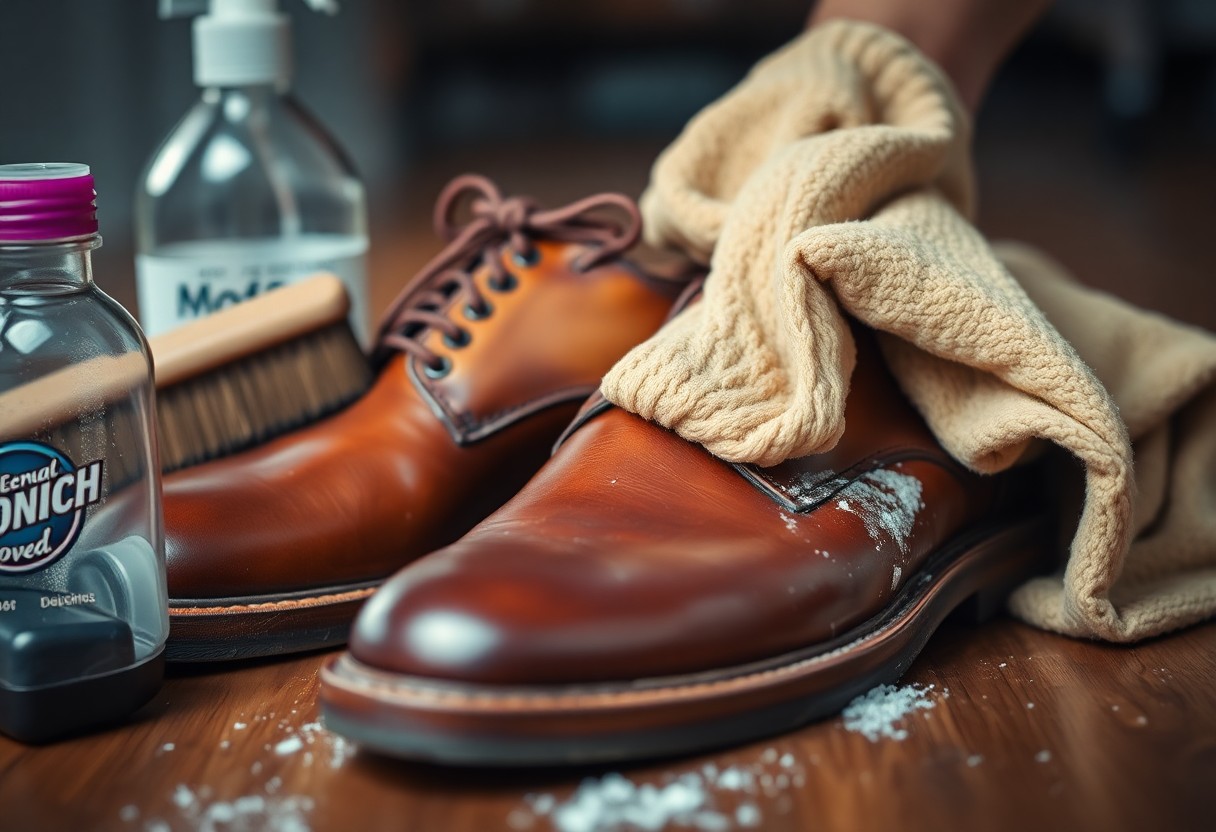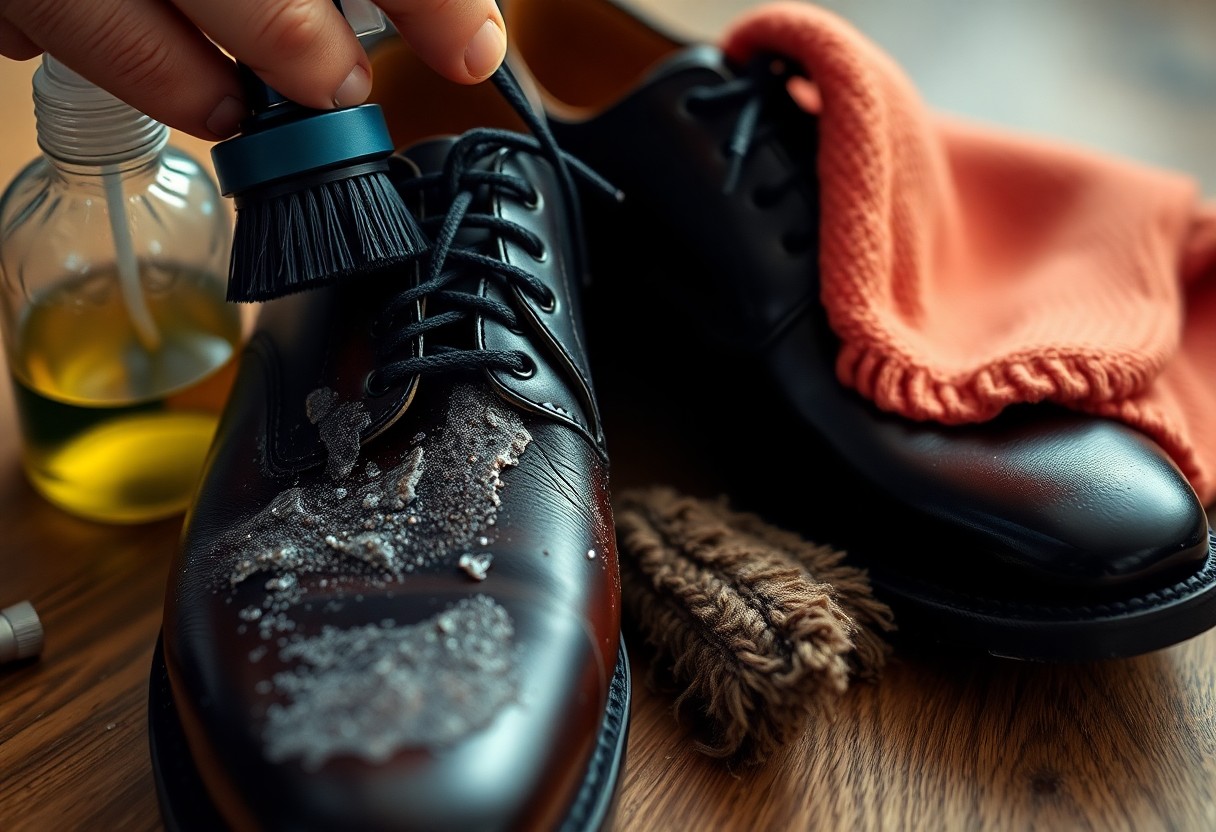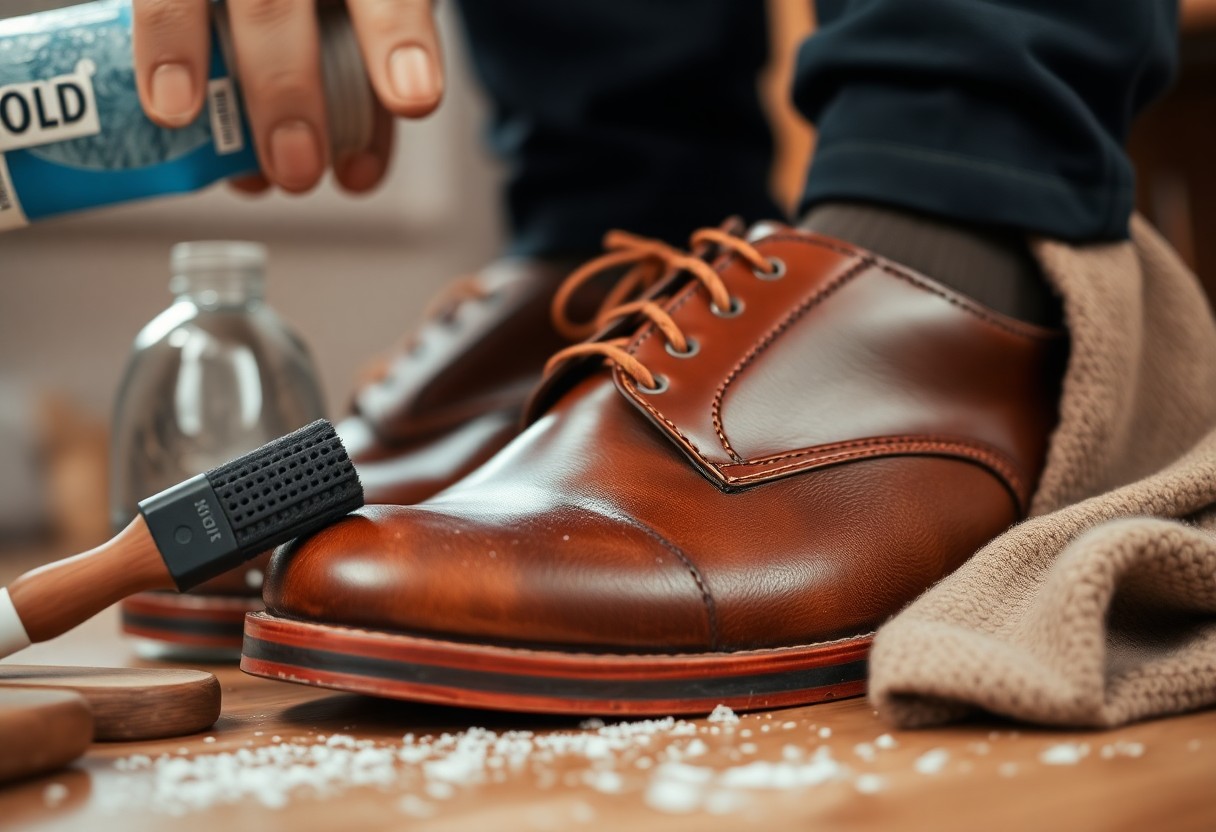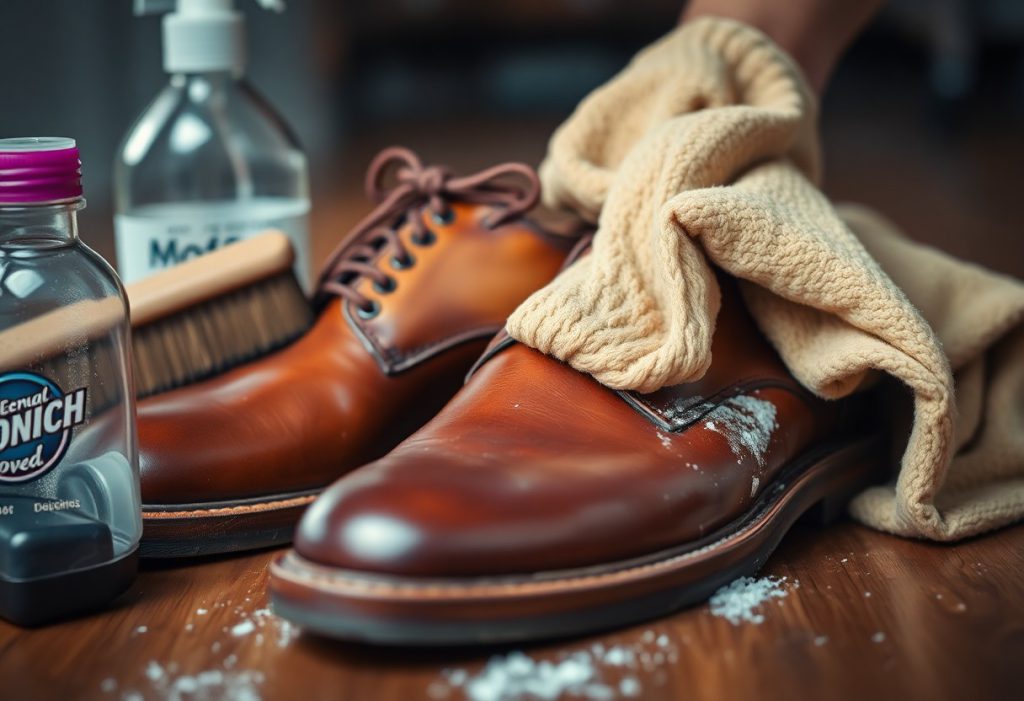This comprehensive guide is designed to equip you with the essential knowledge and practical strategies needed to effectively protect and restore your leather shoes from harmful mould growth. It is vital to understand that if mould is not addressed quickly, it can cause irreversible damage to your leather footwear. Leather shoes are particularly vulnerable to mould in environments with high humidity and poor storage conditions. By adopting effective storage practices and implementing regular maintenance routines, you can keep your leather shoes free from mould, significantly enhancing their longevity. This detailed guide presents proven techniques for preventing mould formation and efficiently eliminating it when it occurs, ensuring your footwear remains in excellent condition.
Understand How Leather and Mould Growth Interact
Gaining a thorough understanding of how leather interacts with mould spores is fundamental for effective shoe care. Your leather shoes are consistently exposed to microscopic fungal spores that exist in our environment. These spores can settle on leather surfaces and begin to proliferate under favorable conditions, potentially leading to severe damage to your cherished footwear. By comprehending the intricate relationship between leather and mould, you can take preventative measures that effectively enhance your shoes’ protection against mould.
Recognize the Different Types of Mould That Can Affect Leather Shoes
Leather shoes can be affected by various types of mould, each bringing its own set of challenges for treatment:
- White mould – This is the most prevalent type, easily identifiable by its fuzzy patches.
- Green mould – Commonly found in damp environments and often indicative of prolonged moisture exposure.
- Black mould – This is the most aggressive type, known for its persistence and difficulty to remove.
- Brown mould – Frequently found on untreated leather surfaces, posing moderate risks.
By identifying the specific type of mould affecting your shoes, you can choose the most effective treatment methods tailored to address the issue efficiently.
| Mould Type | Characteristics |
|---|---|
| White | Fuzzy patches, simple to remove |
| Green | Commonly appears in high humidity |
| Black | Deeply penetrates materials, hardest to treat |
| Brown | Surface-level growth, moderate damage potential |
| Grey | Often found mixed with dust, moderate spread |
Identify Key Environmental Factors That Foster Mould Growth
Certain environmental conditions create ideal circumstances for mould to thrive on your shoes. Recognizing these factors is essential for effective prevention:
- Humidity levels exceeding 60%
- Poor air circulation within storage areas
- Darkness paired with warmth
- Inadequate storage practices
By understanding these environmental factors, you can develop improved storage solutions for your valuable footwear, ensuring they remain protected.
Additionally, recognizing these contributing factors is vital for effective prevention:
- Temperature maintained between 77-86°F
- Lack of adequate ventilation
- Accumulation of moisture in storage
- Extended storage in dark spaces without airflow
This combination of factors establishes optimal conditions for mould growth, highlighting the need for careful consideration in your shoe storage practices.
Adopt Proactive Strategies to Prevent Mould from Forming
To effectively protect your leather shoes from mould, it requires a blend of proactive measures. Your focus should be on creating optimal storage conditions and maintaining consistent care routines to keep your footwear mould-free. Familiarizing yourself with these preventative techniques can save you from costly repairs and potential damage to your shoes in the future.
Ensure Proper Storage Conditions for Your Footwear
To achieve the best shoe storage, ensure you place your footwear in well-ventilated areas where humidity levels consistently remain below 60%. Avoid confining spaces such as sealed closets or damp basements that can trap moisture. Elevating your shoes on raised surfaces or shoe racks promotes air circulation, while using silica gel packets or cedar blocks can effectively absorb excess moisture. This combination of practices will significantly decrease the likelihood of mould growth.
Engage in Regular Maintenance Practices to Enhance Longevity
Even with optimal storage solutions, it is crucial to complement them with a consistent care routine. Clean your shoes after each use, focusing on removing dirt and moisture that can foster mould growth. Utilizing wooden shoe trees not only helps maintain the shape of your footwear but also absorbs moisture generated from daily wear.
Another essential aspect of maintenance is applying a quality leather conditioner every 3-4 months, which keeps the leather supple and resistant to mould growth. Regular inspections of your shoes for any signs of moisture or early mould development, often visible as small white or dark spots, are also important for early intervention.

Follow a Structured Approach for Effective Mould Removal
To effectively eliminate mould from your leather shoes, it’s crucial to follow a systematic process that employs specific tools and methods to ensure safe and effective cleaning without risking damage to your precious footwear.
| Essential Items | Optional Items |
| – White vinegar – Cotton cloths – Protective gloves – Leather conditioner |
– Lemon juice – Shoe cream – Soft brush – Shoe trees |
Start with an Initial Cleaning Process
Begin by taking your mouldy shoes outside to prevent any spores from spreading indoors. Gently wipe away visible mould using a damp cloth soaked in warm water. Allow your shoes to air dry completely before moving on to the next cleaning step, ensuring no moisture remains.
Implement Effective Disinfection Techniques
To effectively eliminate mould, create a solution of 12% vinegar. Apply this mixture evenly across your shoes with a clean cloth, ensuring coverage of all affected areas, including seams and stitching. A thorough disinfection process is crucial for preventing future mould growth.
Treat both the exterior and the interior of your shoes, paying particular attention to hidden areas where mould may develop. After treatment, allow your shoes to dry naturally in a well-ventilated area to ensure complete mould eradication and to avoid any lingering moisture.

Maintain Your Shoes in Optimal Condition After Mould Treatment
To keep your treated shoes in optimal condition, it’s important to monitor them regularly. After mould removal, check your shoes weekly for the first month to ensure that no mould returns. Store them in a well-ventilated area with humidity levels maintained below 65% to prevent future mould growth.
Apply Leather Conditioning for Long-Lasting Protection
Applying small amounts of leather conditioner can significantly extend the lifespan of your shoes. Use a high-quality leather conditioner every 3-4 months to maintain the natural moisture balance of the leather. This regular nourishment is crucial for keeping your shoes flexible and resistant to future mould growth, ensuring they remain in peak condition for longer.
Adopt Preventive Measures for Long-Term Care
For long-term protection, consider applying a water-repellent spray to your leather shoes every six months. This creates a barrier that prevents moisture from penetrating the leather while allowing it to breathe naturally.
Additionally, think about placing silica gel packets or cedar blocks in your shoe storage area. These moisture-absorbing materials can reduce humidity levels by up to 40%, creating an environment where mould spores cannot thrive. Remember to replace these materials every 3-6 months for maximum effectiveness in keeping your shoes safe.
Essential Tools and Products for Effective Mould Prevention and Removal
To effectively prevent and remove mould from your leather shoes, you will need a well-organized toolkit comprising basic tools and products. This toolkit should include protective gear, cleaning solutions, and preventive items that will assist you in maintaining your footwear in optimal condition.
Gather Essential Cleaning Materials
Key cleaning materials include 12% white vinegar solution, cotton cloths, soft brushes, and protective gloves. You’ll also require leather conditioner, shoe cream, and specialized leather cleaners. These materials are vital for safely removing mould without damaging the leather surface of your shoes, ensuring they remain in good condition.
Invest in Preventive Equipment for Effective Care
One of the most critical aspects of leather shoe care is having the right prevention tools. Your essential kit should include wooden shoe trees, silica gel packets, cedar shavings, and moisture-absorbing mats, all of which contribute to maintaining optimal air circulation and controlling humidity levels.
Cleaning and prevention equipment work together to protect your shoes. If you reside in high-humidity areas, a dehumidifier can be an invaluable addition to your shoe care regimen. Ensure your storage space has adequate ventilation, and consider using perforated shoe boxes or open shoe racks to enhance airflow. Regular use of these tools can help you avoid up to 90% of common mould-related issues.

Avoid Common Mistakes in Leather Shoe Care to Prevent Mould
Effective leather shoe care requires specific attention to detail to prevent mould growth. The most common errors include improper drying techniques, the use of direct heat sources, and storing shoes in completely sealed spaces. By understanding these mistakes, you can better safeguard your leather shoes from mould damage and significantly extend their lifespan.
Recognize Storage Errors That Encourage Mould Growth
Storing your shoes in dark, poorly ventilated areas creates ideal conditions for mould to flourish. Shoes require proper air circulation to prevent moisture accumulation. Keeping wet shoes in closed containers or placing them flat on surfaces without airflow can lead to severe mould issues, particularly on leather soles, which can cause them to deteriorate over time.
Avoid Treatment Mistakes That Could Damage Your Shoes
Mistakes made during the mould treatment process can lead to permanent damage to your leather shoes. The use of harsh chemicals, bleach, or incorrect cleaning techniques can compromise the leather’s natural properties. It’s essential to avoid rushing the drying process or using excessive amounts of water during cleaning.
Errors in treatment often occur when you skip crucial steps in the cleaning process. Using unsuitable products, neglecting to treat the entire shoe surface, or failing to condition the leather after cleaning can result in recurring mould problems. Your shoes require thorough care with appropriate cleaning agents like vinegar (12% solution), followed by conditioning to restore the leather’s protective properties.
Empower Yourself with Knowledge and Tools for Effective Shoe Care
Now that you have acquired all the necessary tools and knowledge to protect your leather shoes from mould and effectively tackle any existing mould issues, it’s time to put these strategies into practice. Your regular shoe care routine should include proper drying techniques, suitable storage with excellent air circulation, and the use of moisture absorbers. If you discover mould on your shoes, you can efficiently handle it with a vinegar solution, followed by restoring the leather’s condition with appropriate conditioning afterward. These straightforward steps will enable you to keep your leather shoes in optimal condition while preventing future mould complications.
Your Frequently Asked Questions Answered for Mould Prevention
Q: What preventative measures can I take to stop mould from forming on my leather shoes during storage?
A: To prevent mould, store shoes in a well-ventilated area that offers good air circulation. Avoid dark, humid spaces, and never store damp shoes in closed containers. Utilize wooden shoe trees, silica gel packets, or cedar shavings to absorb moisture effectively. Consider making ventilation holes in shoe boxes if you choose to use them for storage. Elevate shoes off flat surfaces using ribbed carpets or shoe racks to promote airflow underneath.
Q: What is the most effective method for cleaning mould from leather shoes?
A: Start by taking the shoes outside and gently wiping away surface mould with a damp cotton cloth soaked in hot water. Allow them to air dry completely before applying a 12% vinegar solution with a cloth or sponge to eradicate deeper mould. Ensure you cover the entire shoe surface to avoid unsightly water marks. Allow the shoes to air dry thoroughly, then apply leather conditioner and shoe cream to restore moisture and protection to the leather.
Q: What steps should I follow if my leather shoes get wet to prevent mould growth?
A: Start by cleaning wet shoes with a damp cloth to remove any dirt. Dry them in a well-ventilated area at room temperature, steering clear of direct heat sources. Position shoes on their side or an uneven surface to improve air circulation. Avoid placing shoe trees in soaking wet shoes; instead, use newspaper to absorb moisture. Only insert wooden shoe trees once the shoes are partially dry. Replace wet newspaper as necessary until the shoes are completely dry.
The Article Preventing and removing mould from leather shoes tips and effective methods appeared first on My Shoes Finder
The Article Mould Prevention and Removal Tips for Leather Shoes Was Found On https://limitsofstrategy.com



The insights shared in this guide resonate deeply, especially considering how often people overlook proper leather care until it’s too late. I’ve learned this lesson the hard way with a favorite pair of leather boots that succumbed to mould after being stored in a damp corner of my closet. It’s incredible how quickly mould can set in, and as you pointed out, the implications for the leather are often irreversible.
It’s so true how leather care often gets pushed to the background until something like mould sneaks up on us. I think many of us have had that moment of staring at a beloved item, realizing it’s past the point of no return, and wishing we had acted sooner. Your experience with your leather boots resonates with me; I had a similar incident with a leather jacket that was my go-to for years. I stored it improperly, and a bit of dampness did it in. It’s such a poignant reminder of how easily things can deteriorate when we don’t take an active approach to caring for them.
I can totally relate to your experience; it’s surprising how much we take leather for granted until we face a loss, which is why this guide on leather characteristics really opened my eyes to the importance of proper care and appreciation for its qualities.
‘Leather Characteristics: A Comprehensive Guide to Its Uses’
https://lvabj.org/leather-characteristics-a-comprehensive-guide-to-its-uses/.
I really appreciate this guide on maintaining leather footwear, especially the focus on mould prevention. It reminds me of a time when I neglected my favorite pair of leather boots, only to find them invaded by mould one summer when I left them in a damp area. It was heartbreaking to see what had happened; I learned my lesson the hard way.
I can definitely relate to that experience with your leather boots. It’s surprising how quickly mold can take hold in a damp environment, especially during those humid summer months. I once left a leather jacket in a warm closet for just a week, and I ended up with some unwelcome visitors too.